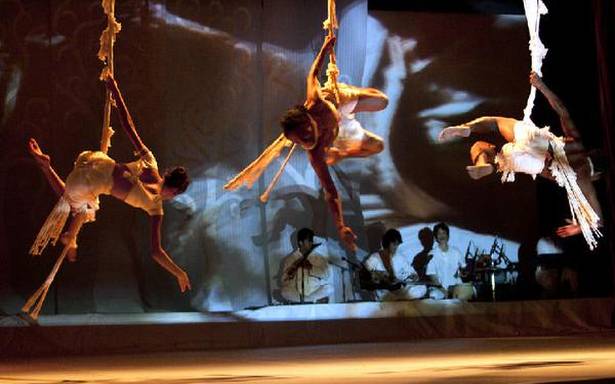Expanding the movement vocabulary will enrich the body, mind and practice
There is a firm belief among some practitioners of dance in India that a comprehensive and holistic approach to the study of dance is also a multidisciplinary one. The International Bureau of Education defines a ‘multidisciplinary approach’ as one that “focuses primarily on different disciplines and the diverse perspectives they bring to illustrate a topic, theme or issue.” A multidisciplinary curriculum is one “where the same topic is studied from the viewpoint of more than one discipline.”
Such an approach to dance, therefore, would include perspectives from more than one movement art. Dance, as is well known, has two dimensions, one bodily or physical and the other mental. So, the multidisciplinary approach to dance is also best viewed as a two-pronged one.
First, it concerns the dancing body. Here ‘multidisciplinary’ could mean understanding the bodily aspects of one’s primary dance form through the additional learning of other dance styles or movement disciplines. Learning other forms expands the body’s physical vocabulary and increases its versatility since different dance forms lay stress on different aspects of muscle strength and offer different kinds of body conditioning in terms of flexibility, balance, reflexes, instinctive awareness, breathing, and so on.
Several dancers have used this approach to better understand their bodies, strengthen and prepare them for dance, and to expand their vocabulary. Among the earliest would be Uday Shankar, who added elements of European theatre, folk and tribal dances to his innovative style. Sitara Devi and Rukmini Devi studied ballet in addition to their primary disciplines of Kathak and Bharatanatyam, respectively.
Tishani Doshi and Shaji John performing Chandralekha’s ‘Sharira’ at Spaces, Chennai | Photo Credit: K_V_SRINIVASAN
Chandralekha turned to yoga as early as the 60s in order to “heal” her “dance ravaged” body and later weaved martial and movement arts into her practice. Cross-cultural dancer Uttara Asha Coorlawala and Kathak dancer Daksha Sheth are other prominent dancers to work with yoga and other movement forms.
Infusing Kathak with yoga
When asked about why she turned to other movement vocabularies, Daksha said, “Kathak was in my body for 20 years” before she saw Chhau and wanted to explore it. “But for a person who has never squatted — we use totally different muscles in Kathak — my body was not capable.” Through injuries, she realised that she needed awareness, conditioning and strengthening. “When I saw a Kalaripayattu demonstration, I thought, this is what I should be learning for a holistic conditioning of my body”. She eventually infused her Kathak choreographies with yoga, Kalaripayattu and Mallakhamb.
The second ‘prong’ of the multidisciplinary approach concerns the dancer’s mind. This involves, in a sense, the ‘fitness’ of the mind. When I speak of the mind, I include intellect, but also mindfulness, emotional intelligence, and other aspects — all crucial for dance. This is best done through a process of informing dance with meditative techniques, but also with disciplines like literature, theatre, music, art, philosophy and so on. As I had asserted in an earlier article for this paper written in 2012, “for any kind of dancing, both body and mind must be exercised equally, and used creatively.”
Hereditary dancers or ‘devadasis’ definitely appear to have approached their art in a ‘multidisciplinary’ fashion. They were rigorously trained in dance but were also expected to have a significant degree of mastery in other arts, be it music (vocal and instrumental), poetry, languages or literature. These past masters of dance knew that learning multiple disciplines can only enrich their dance and inspire creativity.
Chandralekha’s work ‘Namaskar’ | Photo Credit: Sadanand Menon
Like Chandralekha, who drew widely upon sculpture, painting, poetry, literature and philosophy for her dance, Daksha has explored multiple disciplines to create a distinctive contemporary body of work that has been staged to critical acclaim.
Recognising the value of such is crucial to classical dance, particularly its pedagogy, especially if the notions that existed when I was a student of dance persist today. With the exception of music, which was considered complementary to dance, true dedication invariably meant a singular focus on the particular form. A deviation into theatre or sport, for instance, was considered an unwarranted distraction. I remember hearing of heartbroken 12-year-olds who were removed from dance productions because they had enrolled into a weekend theatre class or were led to believe that learning another style of dance or performance would contaminate or dilute their ‘pure’ classical training.
As understandings of dance, the body, inspiration and creativity evolve, my sincere hope for the Indian classical dance world is that it embraces the most holistic of approaches — a multidisciplinary one. I strongly believe this is the most effective way to transformatively enrich one’s body, mind and practice. This confidence comes not just from my own experience as a dancer and choreographer, but from just a cursory glance at how some legendary artistes used this approach to their advantage. In fact, it may have been the secret to their genius.
The dancer and choreographer is the founder-director of Bangalore-based ‘Vyuti’.
Source: Read Full Article


